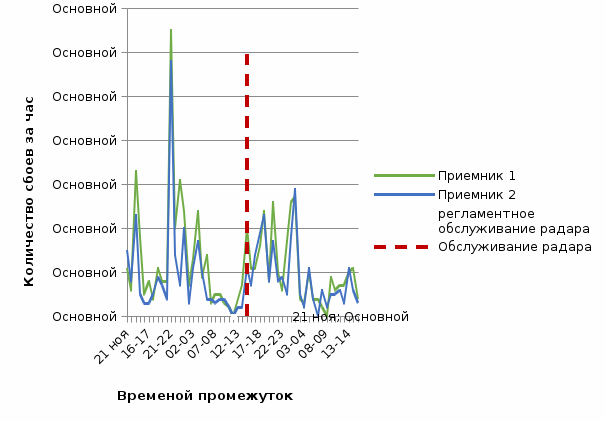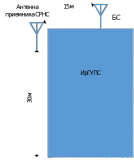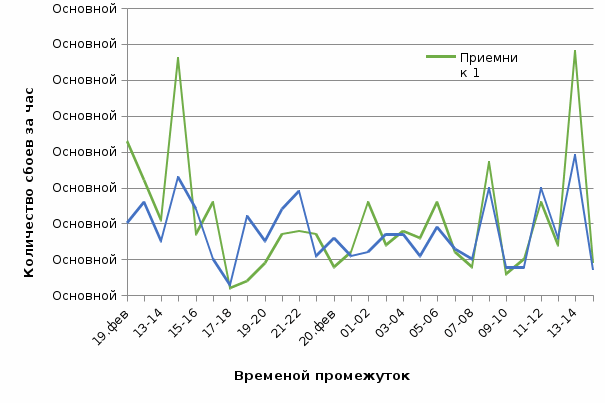ВУЗ: Не указан
Категория: Не указан
Дисциплина: Не указана
Добавлен: 29.10.2023
Просмотров: 10
Скачиваний: 2
ВНИМАНИЕ! Если данный файл нарушает Ваши авторские права, то обязательно сообщите нам.
Introduction
• Reliable reception of signals from satellite radio navigation systems (SRNS) is a necessary condition for the smooth operation of the spatial data infrastructure.
• In urban conditions, reception of navigation satellite signals can be significantly hindered due to the interfering effect of electromagnetic interference.
• The purpose of this study is to assess the radio frequency situation in the working area of the ground equipment of users (NAP) of the SRNS and to identify the degree of influence of individual sources of interference on the quality of functioning of the navigation equipment of users.
This report is devoted to solving the problem: identifying radio equipment that forms interference that prevents the reception of signals from GLONASS and GPS navigation satellites, as well as assessing the nature of the manifestation of these impacts over time
This article will consider RTAs, the frequency of the carrier of which (as well as the frequency of harmonics) can potentially affect the reception of GPS and GLONASS SRNS signals. At the same time, we take into account that the signals of navigation satellites are received at operating frequencies in the frequency bands for GPS L1 (1567-1583 MHz) and L2 (1217-1237 MHz) [1] and for GLONAS L1 (1590-1610 MHz) and L2 (1238-1258 MHz) [2]. The minimum signal power of navigation satellites at the receiving point is about -160DBW[1,2] detailed information is given in Table 1
| Частота, МГц | Компонент сигнала | Мощность, дБВт |
| GPS | ||
| 1227 | СА | -161.5 |
| Р(Y) | -164.5 | |
| 1575 | СА | -158.5 |
| ГЛОНАСС | ||
| 1248 | ВТ | -165 |
| 1600 | СТ | -161 |
| ВТ | -161 | |
Let's look at the frequency plan of GPS and GLONASS systems. From the table on the slide it can be seen that the operating frequencies Are
as we can see , the signal power of navigation systems is very low . This allows us to conclude that powerful sources of interference can have a serious impact on the operation of receivers
| Наименование РТС | Частота несущей и мешающих гармоник, МГц | Режим работы |
| Любительские цифровые радиостанции | 1200/2400 | Непрерывный |
| Сотовая связь | 793,5/800/1587/1600 | Квазинепрерывный |
| Цифровое телевещание | 610/1210 | Случайное включение |
| РЛС системы УВД | 1250..1259 | Импульсный |
The search for possible sources of interference has led to the fact that in urban conditions, the most likely sources may be surveillance radars located on the territories of airports and cell towers. Since their frequency ranges or side harmonics lie in the reception band of navigation systems
На основании обзора данных, приведенных в Таблице 1 и 2, можно сделать вывод, что все представленные системы связи могут оказывать влияние на прием навигационного сигнала, при этом особенно сильное влияние ожидается со стороны РЛС системы управления воздушным движением (УВД) в аэропорту Иркутска, поскольку рабочие частоты этих систем лежат в полосе работы СРНС. Минимальное влияние оказывают любительские радиопередатчики, во-первых, по причине низкой мощности передатчиков, а во-вторых, из-за невостребованности российскими радиолюбителями частотного диапазона 1200 МГц.
-
Two JAVAD Delta multichannel receivers connected to a common antenna were used to conduct the experiment. The DELTA receiver can receive and process signals in two frequency bands and accepts GPS signal components: C/A, L1C (P+D),P1, P2, L2C (L+M), L5(I+Q); GLONASS: CT, L2C, VT1, VT2, L3 (I+Q) -
Among other features of the receiver, we can distinguish a multipath suppression algorithm that allows stable reception of weak signals. -
The receivers recorded data from GPS and GLONASS SRNS with a frequency of 50 Hz. The settings of the noise band of the carrier phase tracking circuit at the receivers differed and amounted to: -
Receiver 1 ΔF =25 Hz -
Receiver 2 ΔF =10 Hz
I want to draw your attention


Why is the noise band of the phase tracking loop important for phase measurements? Pay attention to the formulas presented on the slide . The phase filtering error contains components that directly depend on the band of the phase tracking loop.
however, we see that the dependence in the first case is direct and in the second case is inverse. to assess the effect of the bandwidth, let's look at the following slide where you can see that the phase filtering error increases with increasing Fpl
Результаты эксперимента
3.1. Результаты оценки электромагнитной совместимости навигационного приемника и радиолокационной станции системы УВД
С 21.11.2018 по 23.11.2018 производилась запись навигационных данных с двух приемников JAVAD (настройки приемников указаны выше) при воздействии излучения локатора УВД в аэропорту города Иркутск. Было известно, что локатор должен временно отключаться на регламентные работы в период с 9:00 до 14:00 22.11.2018. Приемник был установлен на удалении 3 км от локатора в здании института.
-
From 21.11.2018 to 23.11.2018, navigation data was recorded from two JAVAD receivers with the specified settings when exposed to radiation from the surveillance radar locator at the Irkutsk airport. It was known that the locator should be temporarily turned off for routine maintenance in the period from 9:00 to 14:00 on 11/22/2018. The receiver was installed at a distance of 3 km from the locator on the building of the MGTU GA.
На рис. 3.1 представлена зависимость количества сбоев от времени работы приемника. Пунктирными лилиями показано время отключения радара на регламентное обслуживание. Оранжевым цветом показано количество сбоев первого приемника (ΔF =25 Гц). Синим цветом количество сбоев второго приемника (ΔF =10 Гц). На вертикальной оси обозначено количество сбоев (штук), а по горизонтальной временные промежутки длинною 1 час, на которых подсчитывалось количество сбоев.
Figure 3.1 shows the dependence of the number of failures on the operating time of the receiver. The dotted lines show the time when the radar was switched off for routine maintenance. The orange color shows the number of failures of the first receiver (ΔF = 25 Hz).In blue, the number of failures of the second receiver (ΔF = 10 Hz).The vertical axis indicates the number of failures (pieces), and the horizontal time intervals of 1 hour long, on which the number of failures was calculated.

Рисунок. 3.1 Зависимость числа отказов в работе навигационного приемника от времени
-
From 21.11.2018 to 23.11.2018, navigation data was recorded from two JAVAD receivers with the specified settings when exposed to radiation from the surveillance radar locator at the Irkutsk airport. It was known that the locator should be temporarily turned off for routine maintenance in the period from 9:00 to 14:00 on 11/22/2018. The receiver was installed at a distance of 3 km from the locator in the building of the MGTU GA.
На рисунке 3.1 видно, что количество сбоев в разные промежутки времени различается. Максимум сбоев наблюдается 21 ноября в промежутке 21-22 часов это вязано с высокой загруженностью аэропорта в этот промежуток времени. Минимум сбоев наблюдается в период отключения радара на регламентные работы, причем в промежутке с 11 до 12 часов сбоев в записи не происходит на двух приемниках одновременно. Интенсивность сбоев приемника 2 в среднем на 14% ниже, чем приемника 1, что позволяет сформулировать рекомендацию к повышению помехоустойчивости навигационного приемника в виде использования более узкой шумовой полосы контура слежения за фазой. В целом можно констатировать существенное влияние радиолокатора системы УВД на устойчивость работы навигационного приемника JAVAD Delta, при его размещении в зоне досягаемости боковых лепестков диаграммы направленности локатора.
Figure 3.1 shows that the number of failures varies at different time intervals. The maximum of failures is observed on November 21 in the interval of 21-22 hours, this is due to the high workload of the airport in this period of time. A minimum of failures is observed during the radar shutdown period for routine maintenance, and in the interval from 11 to 12 hours, recording failures do not occur on two receivers at the same time. The failure rate of receiver 2 is on average 14% lower than receiver 1,
-
In general, we can state a significant influence of the Flight control Radio location radar on the stability of the JAVAD Delta navigation receiver, since the operating frequency of the radar 1250 ...1259 MHz lies in the L2 (1248 MHz) range of the GLONASS. -
The failure rate of receiver 2 (ΔF =10 Hz) is on average 15% lower than receiver 1 (ΔF =25 Hz)
3.2 Оценка электромагнитной совместимости навигационного оборудования с системами мобильной связи.

Рисунок 3.2.1 схема эксперимента
С 12:00 03.03,2019 по 16:00 04.03.2018 производилась запись навигационных данных с двух приемников JAVAD Delta (настройки приемников указаны в разделе 2). Схема размещения аппаратуры показана на рис.3.2.1. Здесь это размещено там то и такт то, а это- там то и так то, расстояние между тем и этим составило столько то метров.
-
From 12:00 03.03,2019 to 16:00 04.03.2019, navigation data was recorded from two JAVAD Delta receivers near a cellular communication tower located on the IRGUPS building. -
The layout of the equipment is shown on the left. The antenna of the SRNS receivers is located at a height of 30 meters , at a distance of 15 meters from the tower of the base station .
Ожидаемой причиной сбоев в работе навигационной аппаратуры здесь может служить работа базовых станций оператора сотовой связи Т2 Мобайл. Базовые станции этого оператора, работающие по технологии LTE Advance, используют частоту 793.5 МГц для соединения базовой станции с аппаратом абонента, вторая гармоника которой составляет 1 587 МГц и, следовательно, попадает в частотный диапазон приема частоты L1 системы ГЛОНАС.
На рисунке 3.2.2 видно, что наибольшее число сбоев происходит в промежутке с 14 до 15 часов в день наблюдения 3.03.2019 и с 15 до 16 часов в день наблюдения 4.03.2019. Это связано с высокой активностью пользователей сотовой сети в зоне охвата базовой станции в этот промежуток времени. В вечернее и, особенно, в ночное время количество сбоев в работе навигационного приемника под воздействием помех от базовой станции сотовой связи падает. Это обусловлено тем, что сотовые аппараты используются не так интенсивно и находятся в режиме ожидания. С наступлением утра количество отказов возрастает и достигает своего пика в дневное время. Таким образом можно сделать вывод о суточной периодичности интенсивности сбоев в работе навигационной аппаратуры
, которая находится в зоне действия помех от базовой станции сотовой связи.
Figure 3.2.2 shows that the greatest number of failures occurs in the interval from 14 to 15 hours on the day of observation 3.03.2019 and from 15 to 16 hours on the day of observation 4.03.2019. This is due to the high activity of cellular network users in the coverage area of the base station during this period of time. In the evening and, especially, at night, the number of failures in the navigation receiver under the influence of interference from the cellular base station decreases. This is due to the fact that cellular devices are not used so intensively and are in standby mode. With the onset of morning, the number of refusals increases and reaches its peak during the daytime. Thus, we can conclude about the daily frequency of the intensity of failures in the navigation equipment, which is located in the area of interference from the cellular base station.

Рис.3.2.2 Зависимость числа отказов в работе навигационного приемника от nonlinear distortionвремени.
-
It should be noted that here, too, receiver 2 with a narrow noise band failed 15% less than receiver 1. In this experiment, the receiver with a narrower noise band of the phase tracking circuit also failed less. -
In general the towers of the cellular base stations(BS) have a significant impact on the stability of the JAVAD Delta navigation receiver, since the frequency of the second harmonic radar of the mobile operator T2 mobile 1587 MHz lies in the L1 (1575 MHz) range of the GLONASS. -
The number of failures has a periodic nature associated with the activity of subscribers in the cellular station coverage area -
The failure rate of receiver 2 (ΔF =10 Hz) is on average 15% lower than receiver 1 (ΔF =25 Hz)
-
According to the results of observations, it was found that in urban conditions, the Flight control Radio location radar and base stations negatively affect the quality of work of the user's ground equipment. At the same time, Flight control Radio location radar failures have the nature of an impact on the RTS, possibly related to the intensity of air traffic. -
Cellular towers have a periodic impact associated with the activity of subscribers in the coverage area. It was found that receiver 1 shows noise immunity lower than receiver 2, which is due to a narrower band of the phase tracking loop. -
To ensure the electromagnetic compatibility, it is recommended to conduct an electromagnetic research of the situation before installing the receivers, install the user's ground equipment at a distance of more than 3 km from the radar and cell towers more than 15 m. -
In the case of operation near the radio systems, a narrow noise band of the phase tracking loop should be adjusted, this will reduce the number of failures of receiving navigation data by the receiver.